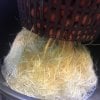GPS Orange Blossom Special cola at 28 days.
View attachment 4170283
And a quick tent shot
View attachment 4170284
There are plants in soil, rockwool, and coco in that tent, they are all on the same reservoir that runs at about pH 7.2 most of the time. They seem pretty healthy to me. If people try to tell you there is one ideal pH range for soil and another for hydro, please refer them to me. It is not always the case. For anyone doing chemical fertigation, the nutrients’ specific formulations are the another factor in the equation. All you organic living supersoil zealots already know everything, surely, so you can disregard this post.
JR Peters Labs claims the base soluble fertilizer I am using allows uptake of all nutrients up to pH 8.0 and I believe it. I think the plants prefer 6.8 but they do fine at 7.2-7.6, so far.
Does anyone else screw around with pH? My experience is that people stress about pH far too much, not only in growing, but the aquarium hobby too. It is important, but not as static or critical as people make it to be.
Hey, whatever happened to
@Cold$moke ? You around, dude?




